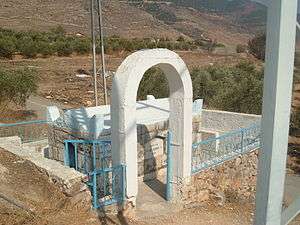Simeon Shezuri
| Rabbinical Eras |
|---|

Simeon Shezuri (or R. Simeon of Shezur, Hebrew: שמעון שזורי, read as Shimon Shezuri) was a Jewish Tanna sage of the fourth generation. His surname Shezuri, is either a variant of the Hebrew word Shezirah (שזירה), and thus stands for his livelihood: Spinning Fibers,[1] or for the village he resided at: Shezor[2] (probably in the vicinity of the Druze community "Sajur" and the modern moshav community "Shezor" that was established nearby). His work is recorded all across the Mishnah (particularly, Demai 4:1;[3] Shevi'it 2:8;[4] Gittin 6:5;[5] Hullin 4:5;[6] Keritot 4:3;[7] Keilim 18:1;[8] Tohorot 3:2;[9] and Tevul Yom 4:5[10])[11] and Talmud. As for his Halakhic rulings in accordance with Halakha, the Amora sages are divided;
Some were in the opinion that:
"wherever R. Simeon Shezuri stated his view, the halakha is in accordance with it"
That is, according to some views, only when R. Simeon Shezuri's opinion is recorded in the Mishnah, and according to other views, even when his opinion is cited in the Baraita.
Other Amora sages, such as R. Jonathan,[13] have ruled that his views are in accordance with the halakha only in two instances: writing a get (divorce document) for the dangerously ill,[5] and terumat hamaaser (a tithe [given to the Kohen]) on produce that belong to an "am ha'aretz" - a "Demai tithe",[3] and so was ruled by the Rishonim sages.[14] Nonetheless, R. Shabbatai ha-Kohen has shown that there are additional instances where the Rishonim have ruled as Simeon Shezuri, yet not in all instances.[15]
He was a pupil of R. Tarfon, and in one of the disputes over the 'Demai tithes', he cites the ruling R. Tarfon had given him when an event occurred to him.[16]
The Talmud did not record anything on his personal life, except for one reference [17] where, according to a version noted by Abraham Zacuto,[18] Solomon Luria,[19] as well as in "Dikdukei Soferim", it is storied that the family of R. Simeon Shezuri were "House proprietors in the Upper Galilee", until they went bankrupt as a Heavenly punishment over their heedlessness on "Dinei mamon" (Halakhic property rights), by herding their sheep on other people's territory, and by giving rulings on "Dinei mamon" in the presence of only one "dayan" (Halakhic judge).
Tomb
A tomb site attributed to Simeon Shezuri is located in Sajur.
The written tradition concerning this tomb site has started in early 13th century era commence, noted by Menachem ben Peretz of Hebron who visited the area in 1215 (ד'תתקע"ה, Hebrew calendar).
References
- ↑ Maimonides' Introduction to his commentary on the Mishnah
- ↑ 'Sefer Yuchasin', by Abraham Zacuto. See also 'Kaftor Vaperach' ("Bulb and Flower"), ch. 44, by Ishtori Haparchi.
- 1 2 Demai 4:1 (in Hebrew).
 משנה דמאי ד א. Wikisource.
משנה דמאי ד א. Wikisource. - ↑ Shevi'it 2:8 (in Hebrew).
 משנה שביעית ב ח. Wikisource.
משנה שביעית ב ח. Wikisource. - 1 2 Gittin 6:5 (in Hebrew).
 משנה גיטין ו ה. Wikisource.
משנה גיטין ו ה. Wikisource. - ↑ Hullin 4:5 (in Hebrew).
 משנה חולין ד ה. Wikisource.
משנה חולין ד ה. Wikisource. - ↑ Keritot 4:3 (in Hebrew).
 משנה כריתות ד ג. Wikisource.
משנה כריתות ד ג. Wikisource. - ↑ Kelim 18:1 (in Hebrew).
 משנה כלים יח א. Wikisource.
משנה כלים יח א. Wikisource. - ↑ Tohorot 3:2 (in Hebrew).
 משנה טהרות ג ב. Wikisource.
משנה טהרות ג ב. Wikisource. - ↑ Tevul Yom 4:5 (in Hebrew).
 משנה טבול יום ד ה. Wikisource.
משנה טבול יום ד ה. Wikisource. - 1 2
 One or more of the preceding sentences incorporates text from a publication now in the public domain: Singer, Isidore; et al., eds. (1901–1906). "SIMEON SHEZURI". Jewish Encyclopedia. New York: Funk & Wagnalls Company. Retrieved Aug/18/13. Check date values in:
One or more of the preceding sentences incorporates text from a publication now in the public domain: Singer, Isidore; et al., eds. (1901–1906). "SIMEON SHEZURI". Jewish Encyclopedia. New York: Funk & Wagnalls Company. Retrieved Aug/18/13. Check date values in: |access-date=(help)
Jewish Encyclopedia bibliography:- Heilprin, Seder ha-Dorot, ii. 365, Warsaw, 1882;
- Frankel, Hodegetica in Mischnam, pp. 131-132;
- Brüll, Einleitung in die Mischna, i. 138.
- ↑ Babylonian Talmud (in Hebrew).
 מנחות ל ב. Wikisource.
מנחות ל ב. Wikisource. - 1 2 Babylonian Talmud (in Hebrew).
 חולין עה ב. Wikisource.
חולין עה ב. Wikisource. - ↑ Asher ben Jehiel and Isaac Alfasi on Gittin
- ↑ Shabbatai ha-Kohen, "Yoreh De'ah", 7
- ↑ Tosefta, Demai 5:24 (in Hebrew); Babylonian Talmud (in Hebrew).
 מנחות לא א. Wikisource.
מנחות לא א. Wikisource. - ↑ Babylonian Talmud, Bava Kamma, 80a
- ↑ Zacuto. ספר יוחסין (in Hebrew). Retrieved Aug/11/13. Check date values in:
|access-date=(help) - ↑ Luria. חכמת שלמה (in Hebrew). p. 802. Retrieved Aug/11/13. Check date values in:
|access-date=(help)
| Wikimedia Commons has media related to Tomb of Simeon Shezuri. |